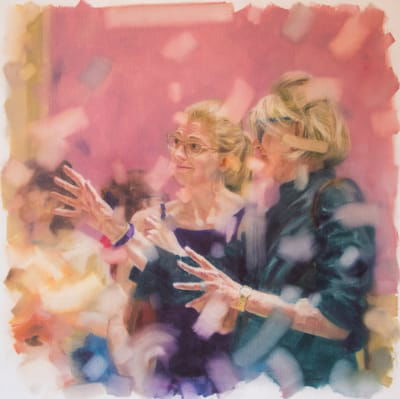Texts

By Gladys Garrote
The voyeur, the snoop, the looker, seeks pleasure in observation: he is pleased to see without being seen. Voyeurism is rather a passive attitude, where satisfaction is built upon the act of contemplation.
As such, observing art is for the most part a voyeuristic action. The work of art as a window to an aesthetic reality offers to the spectator the possibility of immersing himself in another space, of investigating a different medium, of observing situations that happen without his intervention. Aesthetic experience generates aesthetic pleasure; in order to reach it, the subject who perceives investigates the object-art, scrutinizes it, searches over the surface, penetrates it. All this generates a series of sensations that are projected on the body: expressions, movements, gestures...
The museum is the ideal playing field for the practice of artistic voyeurism. Here is where the art voyeurists meet. These are the subjects that interest Marlon Portales, they are the protagonists of his most recent personal exhibition. The Voyeur(1) gathers a set of portraits of anonymous characters that the artist found within different museums in the city. He shows them in the act of contemplation, imbued in dialogue with the artwork, works merely suggested by Portales in the titles of his pieces. The reception, satisfaction and impact that art produces in the spectator seduce the artist; he wishes, therefore, to perpetuate them on canvas.
But doesn't this intention also make Portales a voyeurist?
In the process of creating this series, the artist approaches his characters clandestinely. The act of perception to be represented must be authentic: the spectator must not feel observed. The reaction to aesthetic pleasure takes place in the public space of the museum, but the action itself is private and, if you will, solitary. Camouflaged as a visitor, Portales gets close to these characters who do not even notice him. His actions are indiscreet and invasive, but like any good voyeur he avoids being discovered.
Then in the intimacy of his workshop he selects his models to take to the canvas. That is when his voyeuristic action ceases to be passive. The re-presentation of pleasure focuses him in on the characters and their expressions. He constructs them by recreating the traces that art has left on their faces, in their gestures: he alludes to iconic works by the impact they have on the contemporary spectator.
The result which the exhibition offers now makes us meta-vouyeurists: we know that we attend to the result of a clandestine act, we participate in the impertinence of Marlon Portales and with our own perception we perpetuate the invasion of the intimate act of these characters. We recognize ourselves in them, in our own act of self-contemplation, we identify ourselves with he whom is looking -who observes us- who is now the painting itself.
(1)The Voyeur brings together pieces from the Museum series that began in 2017.